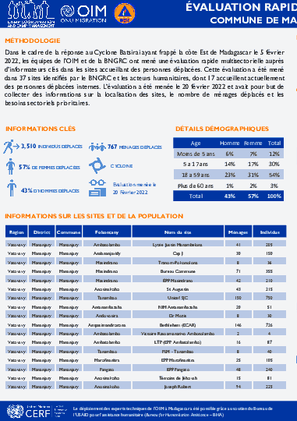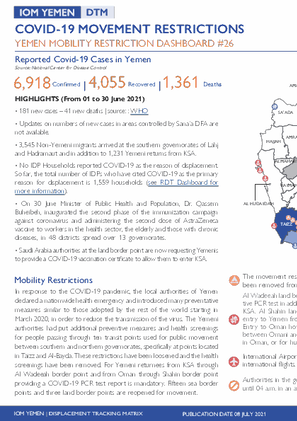-
Countries
-
Data and Analysis
-
Special Focus
-
Crisis Responses
Contact
DTM Yemen, iomyemendtm@iom.int
Location
Yemen
Activity
- Event Tracking
- Mobility Tracking
Period Covered
Feb 13 2022 -Feb 19 2022
From 01 January 2022 to 19 February 2022, IOM Yemen DTM estimates that 3,368 households (HH) (20,208 Individuals) have experienced displacement at least once.
Since the beginning of 2022, DTM also identified 11 displaced households who left their locations of displacement and either moved back to their place of origin or another location.
Between 13 and 19 February 2022, IOM Yemen DTM tracked 202 households (1,212 individuals) displaced at least once. The majority of people moved into/within the following governorates and districts:
• Marib (81 HH) – Marib City (43 HH), Harib (30 HH), Marib (8 HH) districts. Most displacements in the governorate originated from Marib and Al Jawf.
• Al Hodeidah (54 HH) – Hays (40 HH), Al Khukhah (14 HH) districts. Most displacements in the governorate originated from Al Hodeidah and Taiz.
• Ad Dali (35 HH) – Qatabah (23 HH), Ad Dali (10 HH), Al Hasayn (2 HH) districts. Most displacements in the governorate originated from Ad Dali and Al Hodeidah.
The majority of people moved from the following governorates and districts
• Al Hodeidah (59 HH) – Hays (34 HH), Al Khukhah (6 HH), At Tuhayta (6 HH) districts.
• Marib (52 HH) – Harib (40 HH), Al Jubah (6 HH), Al Abdiyah (2 HH) districts.
• Taiz (32 HH) – Maqbanah (20 HH), Jabal Habashi (10 HH), Sabir Al Mawadim (2 HH) districts.
Population Groups
Survey Methodology
Unit of Analysis Or Observation
Type of Survey or Assessment
Keywords
Geographical Scope
Administrative boundaries with available data
The current dataset covers the following administrative boundaries

Contact
DTM Yemen, iomyemendtm@iom.int
Language
English
Location
Yemen
Period Covered
Feb 13 2022
Feb 19 2022
Activity
- Rapid Emergency Registration
- Mobility Tracking
IOM Yemen DTM’s Rapid Displacement Tracking (RDT) tool collects data on estimated numbers of households forced to flee on a daily basis from their locations of origin or displacement, allowing for regular reporting of new displacements in terms of estimated numbers, geography, and needs. It also tracks Returnees who returned to their location of origin.
From 01 January 2022 to 19 February 2022, IOM Yemen DTM estimates that 3,368 households (HH) (20,208 Individuals) have experienced displacement at least once.
Since the beginning of 2022, DTM also identified 11 displaced households who left their locations of displacement and either moved back to their place of origin or another location.
Between 13 and 19 February 2022, IOM Yemen DTM tracked 202 households (1,212 individuals) displaced at least once. The majority of people moved into/within the following governorates and districts:
- Marib (81 HH) – Marib City (43 HH), Harib (30 HH), Marib (8 HH) districts. Most displacements in the governorate originated from Marib and Al Jawf.
- Al Hodeidah (54 HH) – Hays (40 HH), Al Khukhah (14 HH) districts. Most displacements in the governorate originated from Al Hodeidah and Taiz.
- Ad Dali (35 HH) – Qatabah (23 HH), Ad Dali (10 HH), Al Hasayn (2 HH) districts. Most displacements in the governorate originated from Ad Dali and Al Hodeidah.
The majority of people moved from the following governorates and districts
- Al Hodeidah (59 HH) – Hays (34 HH), Al Khukhah (6 HH), At Tuhayta (6 HH) districts.
- Marib (52 HH) – Harib (40 HH), Al Jubah (6 HH), Al Abdiyah (2 HH) districts.
- Taiz (32 HH) – Maqbanah (20 HH), Jabal Habashi (10 HH), Sabir Al Mawadim (2 HH) districts.

Contact
DTM Libya, DTMLibya@iom.int
Language
English
Location
Libya
Period Covered
Feb 13 2022
Feb 19 2022
Activity
- Other
As part of the the second phase of the Libyan national COVID-19 vaccination campaign led by the Libyan National Centre for Disease Control (NCDC), IOM conducted awareness raising sessions on COVID-19 vaccines with a total of 584 adult migrants (81 females and 503 males) in two locations, Ain Zara detention centre and a community setting in Hai Alandalus municipality during the reporting period (13 - 19 Feb 2022).

Contact
DTM Guinée, oimguineedtm@iom.int
Language
French
Location
Guinea
Period Covered
Jan 01 2022
Jan 31 2022
Activity
- Survey
- Flow Monitoring
Le suivi des flux de populations (Flow Monitoring, FM) est un exercice qui vise à identifier les zones de forte mobilité interne et transfrontalière à fin de mieux comprendre les caractéristiques des flux migratoires. Ce rapport présente les données obtenues pendant le mois de Janvier 2022 au niveau des FMPs de Boundoufourdou dans la préfecture de Koundara au Nord du pays et de Kourémalé dans la préfecture de Siguiri au Nord-Est de la Guinée. Ces données sont collectées lors de l’enregistrement des flux effectués auprès des voyageurs.

Contact
mtherrien@iom.int; ahabdi@iom.int
Language
French
Location
Madagascar
Period Covered
Feb 20 2022
Feb 20 2022
Activity
- Site Assessment
Dans le cadre de la réponse au Cyclone Batsirai ayant frappé la côte Est de Madagascar le 5 février 2022 les équipes de l’OIM et de la BNGRC ont mené une évaluation rapide multisectorielle auprès d’informateurs clés dans les sites accueillant des personnes déplacées Cette évaluation a été mené dans 37 sites identifiés par le BNGRC et les acteurs humanitaires, dont 17 accueillent actuellement des personnes déplacées internes L’évaluation a été menée le 20 février 2022 et avait pour but de collecter des informations sur la localisation des sites, le nombre de ménages déplacés et les besoins sectoriels prioritaires

Contact
Regional Office Dakar, RODakar-DataResearch@iom.int
Language
English
Location
The Gambia
Period Covered
Nov 01 2021
Nov 30 2021
Activity
- Survey
- Flow Monitoring Survey
- Flow Monitoring
In The Gambia, DTM conducts Flow Monitoring activities at several important transit locations in:
1) Barra (FMPs are located at the ferry terminal and the main garage);
2) Farafenni (FMPs are located at Farafenni main garage, Farafenni Ballan-Ghar garage, Farafenni McCarthy and Sanjally garage, Farafenni turntable garage and the truck garage);
3) Basse (FMPs are situated at the main garage and the bus station in Basse Santa-Su) and
4) Brikama (FMPs are located at the main garage and the Bus station).
These activities enable DTM to monitor the movements of passengers within, out of and towards The Gambia as well as the movements of those passengers transiting The Gambia.
This report presents the key results from the Flow Monitoring Survey conducted in November 2021 2021. The report presents data collected on flows, routes, departure, destination and demographic profiles of travellers observed at the FMPs.

Contact
DTM Yemen, iomyemendtm@iom.int
Language
English
Location
Yemen
Period Covered
Jun 01 2021
Jun 30 2021
Activity
- Mobility Tracking
- Points of Entry (PoE)
HIGHLIGHTS (From 01 to 30 June 2021)
• 181 new cases – 41 new deaths | source: WHO
• Updates on the numbers of new cases in areas controlled by Sana’a DFA are not available.
• 3,545 Non-Yemeni migrants arrived at the southern governorates of Lahj and Hadramaut and in addition to 1,231 Yemeni returns from KSA.
• No IDP Households reported COVID-19 as the reason of displacement. So far, the total number of IDPs who have cited COVID-19 as the primary reason for displacement is 1,559 households (see RDT Dashboard for more information).
• On 30 June Minister of Public Health and Population, Dr. Qassem Buheibeh, inaugurated the second phase of the immunization campaign against coronavirus and administered the second dose of AstraZeneca vaccine to workers in the health sector, the elderly and those with chronic diseases, in 48 districts spread over 13 governorates.
• Saudi Arabia authorities at the land border point are now requesting Yemenis to provide a COVID-19 vaccination certificate to allow them to enter KSA.

Contact
DTMMozambique@iom.int
Language
English
Location
Mozambique
Period Covered
Feb 09 2022
Feb 15 2022
Activity
- Event Tracking
- Mobility Tracking
During the reporting period (09 to 15 February 2022), a total of 45 movements were recorded – 39 Arrivals (1,885 individuals), 1 transit (63 individuals) and 5 departures (126 individuals). The largest arrival movements were recorded in Nangade (697 individuals), Cidade de Pemba (619 individuals), Montepuez (214 individuals), and Metuge (142 individuals). The largest departure was observed in Mueda (53 individuals). Of the total population captured by the ETT, 78 per cent were displaced for the first time, and 22 per cent of reported IDPs had been displaced more than once prior to this latest movement.

Contact
dtmsudan@iom.int
Language
English
Location
Sudan
Snapshot Date
Feb 20 2022
Activity
- Event Tracking
- Flow Monitoring Survey
- Registration
- Flow Monitoring
DTM is a system to track and monitor displacement and population mobility. It is designed to regularly and systematically capture, process and disseminate information to provide a better understanding of the movements and evolving needs of displaced populations, whether on site or en route. Data collection strategies and tools are based on the DTM global methodology but have been adapted to reflect the context and population movements specific to Sudan.
This product outlines DTM's methodological components operating currently in Sudan namely, Mobility Tracking, Early Warning Flash Alerts and Emergency Event Tracking, Situation Assessments, Registration Activities, Flow Monitoring Registry and Integrated Location Assessment.

Contact
Angelica Madrigal amadrigal@iom.int / Miranda Mora mmora@iom.int
Language
English
Location
Costa Rica
Period Covered
Jan 01 2022
Jan 31 2022
Activity
- Survey
- Flow Monitoring
Within the framework of the COVID-19 emergency, since March 19, 2020, the Government of Costa Rica has kept its land border with Panama closed, and the Binational Controlled Flow Operation, agreed between the governments of Costa Rica and Panama at the Paso Canoas border to ensure an orderly and safe migration of migrants moving through the Americas, was stopped. As of the date of this report, there is no approximate date for its reimplementation.
Given the presence of this irregular migration flow, since August 24, 2021, IOM Panama has published information on the irregular migration flow in Darien, Panama under the context of COVID-19. Based on this information, it has been identified that during 2021 the flow of people in a situation of mobility through the Americas with destination to North America is on the rise: according to SNM data, in the period between August and November 2021, the irregular entry of 126,675 migrants of different nationalities has been registered at the border between Colombia and Panama: Haiti (62%), Cuba (13%), Chile (8%), Brazil (7%), Bolivarian Republic of Venezuela (2%), among other countries in South America, Africa and Asia.
In Costa Rica, an increase has been identified in the number of migrants from the migration flow who decide to stay in the country, mainly people from Haiti, who, in some cases, have requested refuge in the country before the General Directorate of Migration and Foreigners (DGME). According to data from the DGME, between May and December 2021, 4,296 rejections were carried out in Paso Canoas.